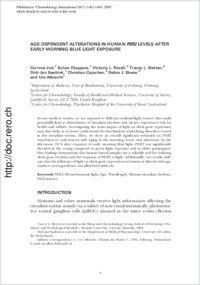Age-dependent alterations in human PER2 levels after early morning blue light exposure
- Jud, Corinne Department of Medicine, Unit of Biochemistry, University of Fribourg, Switzerland
- Chappuis, Sylvie Department of Medicine, Unit of Biochemistry, University of Fribourg, Switzerland
- Revell, Victoria L. Centre for Chronobiology, Faculty of Health and Medical Sciences, University of Surrey, Guildford, UK
- Sletten, Tracey L. Centre for Chronobiology, Faculty of Health and Medical Sciences, University of Surrey, Guildford, UK - Sleep and Chronobiology Group, School of Psychology, Psychiatry and Psychological Medicine, Monash University, Victoria, Australia
- Saaltink, Dirk-Jan Department of Medicine, Unit of Biochemistry, University of Fribourg, Switzerland - Department of Medical Pharmacology, University of Leiden, the Netherlands
- Cajochen, Christian Centre for Chronobiology, Psychiatric Hospital of the University of Basel, Switzerland
- Skene, Debra J. Centre for Chronobiology, Faculty of Health and Medical Sciences, University of Surrey, Guildford, UK
- Albrecht, Urs Department of Medicine, Unit of Biochemistry, University of Fribourg, Switzerland
-
2009
Published in:
- Chronobiology International. - 2009, vol. 26, no. 7, p. 1462-1469
English
In our modern society, we are exposed to different artificial light sources that could potentially lead to disturbances of circadian rhythms and, hence, represent a risk for health and welfare. Investigating the acute impact of light on clock-gene expression may thus help us to better understand the mechanisms underlying disorders rooted in the circadian system. Here, we show an overall significant reduction in PER2 expression in oral mucosa with aging in the morning, noon, and afternoon. In the afternoon, 10h after exposure to early morning blue light, PER2 was significantly elevated in the young compared to green light exposure and to older participants. Our findings demonstrate that human buccal samples are a valuable tool for studying clock-gene rhythms and the response of PER2 to light. Additionally, our results indicate that the influence of light on clock-gene expression in humans is altered with age.
- Faculty
- Faculté des sciences et de médecine
- Department
- Département de Biologie
- Language
-
- English
- Classification
- Biological sciences
- License
-
License undefined
- Identifiers
-
- RERO DOC 17260
- DOI 10.3109/07420520903385564
- Persistent URL
- https://folia.unifr.ch/unifr/documents/301392
Statistics
Document views: 128
File downloads:
- pdf: 195
